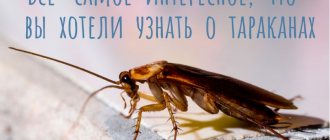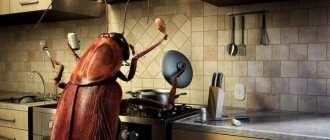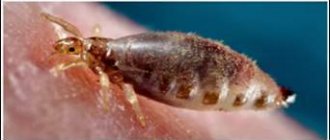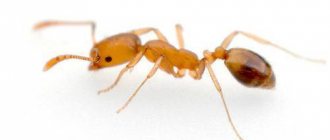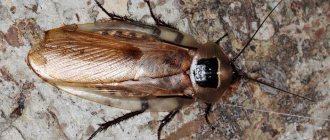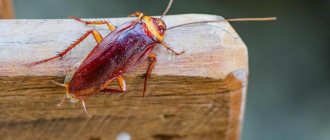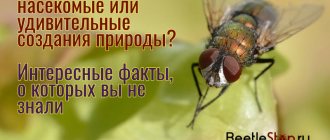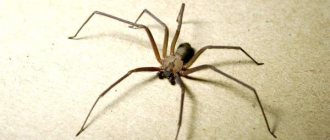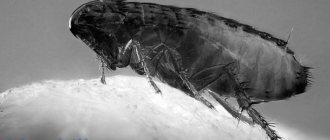Almost all of us can quickly recognize a cockroach. Probably every person has seen this insect more than once; they usually come in two colors - these are representatives of black and brown individuals. At the same time, they differ in their length. How long are they? Some species can reach a size of 50 mm in length. The minimum size is 12 mm.
Cockroaches usually have their heads towards the ground. From the outside it may seem that they are always trying to bow to someone. Unlike females, males have wings. However, they do not use them. As for the females of these insects, they have practically no wings. They are very small and are rather rudimentary in nature, which indicates their absolute underdevelopment.
It should be noted that insects that represent different species also have a number of common features that are present in all genera without exception. How many of these common features are there and what are they?
- How many parts does an insect's body have? The body has three main parts - the head, abdomen and thorax.
- How many legs do they have? All members of the cockroach family have three pairs of articulated legs.
- All have only one pair of antennae.
- They have a hard chitinous type of cover.
- Over time, when they become adults, they shed their outer shell. They are also susceptible to molting. This procedure is repeated several times throughout their lives.
- When the molting process takes place, they turn white. Moreover, this period is the most vulnerable for them. Only over time, a special hormone that insects have, called bursicon, causes the cover to darken again, after which it becomes hard.
- Representatives of all types of cockroaches have the ability to regrow limbs, which they can lose during molting. This is a unique property of insects of this class.
Interesting Facts
- Tsar Peter the Great was terrified of cockroaches.
- Some representatives of this order of insects are used in rather exotic events - cockroach races.
- Cockroaches in sugar is one of the traditional dishes of Chinese cuisine.
- Without a head, a cockroach can live up to nine days.
- If desired, this insect can regrow lost limbs.
- A female cockroach lays about two million eggs per year.
- If a cockroach turns upside down, it will not have much of a chance to return to its original position.
- These amazing insects can hold their breath for 30-40 minutes.
- Every 15 minutes, cockroaches release gases, which contribute to the global warming of our planet.
Due to the fact that black cockroaches have been known to mankind for more than 3 centuries, various beliefs and unusual facts associated with these insects have appeared at different times.
For example, in the old days, cockroaches often hid behind a warm stove, which is why they began to be called “baked dwellers.” There was also a legend that the appearance of black barbels in the house promised wealth to the owners, so they even fed them and took them with them when moving to a new home. Ancient healers prepared a healing potion from cockroaches, used for digestive disorders. It consisted of garlic and insects fried in oil.
In Asian countries such as Thailand, South Korea, Cambodia and Vietnam, cockroaches are still considered an essential component of many national dishes. They are eaten fried, stewed and dried, and are also offered to all tourists to try. Such food preferences are explained by the high content of high-quality protein in the body of insects.
Scientists entomologists, in the process of many years of studying various insects, discovered an interesting fact that cockroaches are not affected by radiation due to their slow biological processes.
According to archaeological excavations, cockroaches appeared during the period of dinosaurs and reached sizes of 50 cm in length or more. Modern data confirms another fact - cockroaches are able to sense the approach of heavy rain, which is why they diligently rush to take cover even at night.
The life of cockroaches is inextricably linked with human life, which is why there are frequent cases of dreams involving these insects. To understand why black cockroaches are dreamed of, you should turn to specialized interpretative books.
For the most part, such dreams report joyful events, success in business and well-being (even if there were a lot of insects and they attacked a person).
Meet the Cockroach squad
Type: Arthropods. Class: Insects. Order: Cockroaches. This is the scientific taxonomy of creatures that are feared and hated by most of the population. In general, the general human dislike for cockroaches is quite understandable and justified. After all, these insects spoil books and food products, destroy house plants, and carry a number of dangerous diseases (for example, dysentery).
Where the word “cockroach” came from in Russian is unknown. According to one version, it comes from the Chuvash tar aqan (“runaway”). A similar-sounding word (tarqan) also exists in Turkic languages, but it is translated as “dignitary.”
Cockroaches are incredibly mobile insects that are primarily nocturnal. They prefer to settle in well-moistened and fairly warm places. They feed mainly on animal and plant debris. Legends are made about the phenomenal endurance of these insects. They are indeed resistant to radiation, but not as much as fruit flies, for example.
It should be noted that cockroaches are not perceived with hostility by people everywhere. So, in some regions of the planet they are eaten or used as medicine. In Ancient Rus' they did not even think about fighting cockroaches. The presence of these insects in the house was then considered a sign of wealth and well-being.
External features of a cockroach
The structure and general characteristics of the cockroach are the same for almost all representatives.
Almost all cockroaches are distinguished by the oval shape of their body. As for the head of this insect, it comes in two shapes - triangular and heart-shaped. On its sides there are two long antennae, the so-called antennae, as well as two compound eyes, except for the structure of cave species.
Cockroaches have a fairly strong oral apparatus, which is classified as gnawing, as well as two wings consisting of an elytra and the wing itself. A distinctive sexual feature is that the female has an egg cocoon hidden inside the abdomen, and the males have a genital plate at the end of the body.
The back of cockroaches is covered with a shell, under which there are two wings, but they cannot fly with their help, only glide when falling. Of all the existing species, there are wingless species and flying ones.
As for the internal structure of cockroaches, the respiratory, digestive and blood supply organs are of particular interest.
As for the digestive system of these parasites, it begins with the oral cavity, followed by the subglottis and salivary glands. Saliva has a very important role, since it is thanks to it that food is wetted.
Despite the fact that cockroaches have wings, they do not use them for their intended purpose. Insects use this part of their body to significantly slow down their fall when gliding from a height, as well as to develop speed while running. Among other things, the wings are used by males to demonstrate to the female their readiness for sexual intercourse.
As for how many legs a cockroach has, all varieties of parasites have six of them, the legs are located on both sides of the chest.
Structure of a cockroach
Each pair of limbs of a cockroach performs its own specific functions, which are as follows:
- the forelimbs play the role of brakes and are distinguished by the fact that they are much shorter than all the others;
- the middle limbs serve to provide the insect with maneuverability, and also allow these parasites to move in different directions;
- the hind limbs are the longest and act as a kind of pushing mechanism.
As already noted, the cockroach is an easily recognizable insect. Its body is elongated from the head to the back and is segmented into several sections. Colors range from dark brown to reddish brown, this is the color we are accustomed to when observing pests in our apartment.
The outer shell of the insect is dense and hard, consisting of calcareous layers called sclerites. A total of ten such segments are distinguished, which are equally distributed on the dorsal and abdominal parts of the insect. The segments on the dorsal side, or notum, are called tergum, and those on the ventral side are called sternum.
The chitinous cover is covered on the outside with wax, which is impermeable to water. It protects the body from loss of moisture and provides rigidity to maintain the anatomical shape of the insect’s body, as well as a surface for muscle attachment. Adjacent segments are connected to each other by a thin, soft and flexible membrane, in a word, they are still knights in armor.
The forewings are mesothoracic, they are also called elytra. They cover the entire thoracic region of the body and part of the abdominal cavity. The hind wings are located slightly lower than the front wings. Both pairs perform exclusively protective functions. To date, the red cockroach has not been observed to fly, although it is anatomically and physiologically possible.
How many legs do different types of cockroaches have?
The Madagascar cockroach remains quite exotic for the average person in traditional multi-storey buildings. It is not found in ordinary people's homes. Most often it can be seen at various entomological exhibitions. Having seen such a creature, children often ask how many legs the Madagascar cockroach has. The fact is that its abdomen is very large and it is not always possible to see the number of limbs behind it. However, like all its brothers, the number of legs is the same and is equal to six.
This type of cockroach is impressive in size. Some individuals reach 8-9 cm. An additional property of the insect is the ability to make a sound similar to a hiss. It is seen as a defense mechanism and a way to attract a female for fertilization.
The legs of the Madagascar cockroach are relatively small in relation to its body. They must withstand a large mass, so their segments have well-developed muscles. With their help, he can move quickly and crawl onto different surfaces.
This is due to the common origin of insects with similar principles of development. The only thing that may differ is the strength and size of the corresponding body parts. This fact has virtually no effect on the problem of the invasion of Prussians in the apartment, but may be of particular interest to individual entomologists and insect lovers.
If you are interested in taking a closer look at the structure of a cockroach, the best way to do this is with Madagascar individuals:
Notes
- Robert G.
Foottit, Peter H. Adler Insect Biodiversity: science and society. - Blackwell Publishing Ltd, 2009. - P. 31. - 642 p. — ISBN 978-1-4051-5142-9 - For more details, see M. Vasmer. "Etymological dictionary of the Russian language." Volume IV, M., “Progress”, 1987, pp. 20-21, approx. O. N. Trubacheva.
- Article Cockroaches are afraid to exhale water
- www.infox.ru/science/animal/2009/08/18/Tarakanyy_boyatsya_v.phtml on the website
www.infox.ru - Article Survivors of a nuclear war... and the guillotine
- www.sciam.ru/news/2007/04/02/1442.html on the website
www.sciam.ru
The females of some cockroaches bear an ootheca at the end of their abdomen.
The giant cockroach is sometimes introduced along with bananas to temperate countries.
Cockroach limbs
If you look closely at the structure of a cockroach, you will notice that its paired legs are separate from the body. At the same time, they are able to move using muscular force.
How many legs does this insect have? It is now reliably known that all representatives of this insect species have six legs.
How many legs are there in the thoracic region? Three pairs of walking-type legs are attached to the thoracic part of the body of the cockroach, with the help of which they can move.
All pairs of legs have their own name. It is determined by the name of the area of the thoracic part of the insect's body to which they are attached.
Pairs of cockroach paws are named as follows:
- A pair of paws of the prothoracic type. This pair of limbs is located closest to the head. These legs are the shortest. Their main function is braking in the process of reducing speed when the insect finishes running.
- A pair of paws of medium-thoracic type. These legs have the ability to move both backwards and forwards. This helps the cockroach, if necessary, speed up or, conversely, slow down its movement.
- Pair of metathoracic paws. These legs are considered the longest in this insect species. They are located in the back of the body. With the help of such legs, cockroaches can move their body forward. This pair of legs is the main one in performing the walking function.
It should be noted that anatomically the body of a cockroach is designed in such a way that all pairs of its legs differ significantly from each other in their length, as well as in the functions they perform. Moreover, they have almost the same segmental structure. They also have the same functions of flexion and extension.
How many claws do cockroaches have? At the tips of each of the legs there are several sharp claws, which allows insects to cling to any type of surface. This applies to vertical walls as well as ceilings.
It should be noted that from an anatomical point of view, the structure of the legs of cockroaches gives them the opportunity to develop high speeds.
As can be seen from the above, their limbs play very important functions and allow them to move in various planes at high speed. If necessary, cockroaches, using their limbs, can quickly brake and change the direction of movement.
https://youtube.com/watch?v=G6ZFDbgZ_2Q%3Frel%3D0
Why do people keep Madagascar hissing cockroaches?
Madagascar cockroaches are harmless insects. They are not capable of harming a person, much less biting him. They do not emit any unpleasant odors. The hissing of insects may unnerve some people at first, but owners quickly get used to it and even begin to get bored when cockroaches are silent. Cockroaches cannot cause any allergies in humans. All of the hissing cockroaches in some people have a nervous origin and pass without a trace as soon as a person gets used to the insect.
Keeping insects at home is interesting and exciting. Some owners organize exciting cockroach races. Others simply admire them, enjoying their presence in the house. The Madagascar cockroach often brings in quite a bit of income.
Types of Insect Limbs
The most ancient are the running and walking legs of insects. The remaining types of limbs appeared in the process of long-term development, and, as a rule, are associated with various adaptations to environmental conditions.
Running limbs
The running legs have an elongated shape. They are slender, and the tarsus, lower leg, thigh and coxa are narrow or wide. This type of limbs is present in cockroaches and ground beetles.
walking legs
Walking legs are designed for slow movement. These are the legs of beetles - longhorned beetles, leaf beetles, crawling from leaf to leaf, leisurely gnawing leaves.
Insects need limbs to move around.
Swimming limbs
The hind legs of insects usually become swimming, and less often the middle legs. They are covered with long hairs that form a wide rowing surface - a kind of oar. Basically, representatives with such limbs live in bodies of water and swim and dive excellently. These are swimming beetles, smooth bugs, and water lovers.
Jumping legs
Representatives of the order Orthoptera have jumping legs. These include locusts, grasshoppers, and crickets. Their last pair of legs is very long and powerful. Many representatives of Orthoptera jump in heights of up to eighty centimeters, and if they spread their wings at the same time, the distance covered in one jump reaches about ten meters.
Digging legs
Digging legs are characteristic of the mole cricket, dung beetle, and May beetle. Usually the first pair of legs become digging legs. The limbs of this type are powerful, flat and short.
The legs of grasshoppers give them the ability to move tens of meters in a matter of seconds.
Collective limbs
The limbs of bees and bumblebees are called collective or basket limbs. On the hind legs of these insects there are special areas surrounded by long chitinous hairs; these are baskets. Bees move from flower to flower and get dirty in the pollen that sticks to the hairs of their bodies. With special brushes located on the legs, the bee collects flower pollen into baskets.
the adhesive dust particles form a lump called “polnoka”. The bee carries pollen into the hive and deposits it in the honeycomb. Bee bread soaked in nectar is formed; it serves as a reserve protein food for the entire bee family.
Thanks to the collecting type of legs, the bee can “save” pollen.
Grasping legs
Grasping legs of a praying mantis. They are armed with sharp spines, which the predator uses to hold its prey.
Suction limbs
The legs of males of some species of insects - swimming beetles and ground beetles - have expanded segments at the ends of the legs. During the breeding season, males use these devices to grasp females during mating.
Grasping legs help not only to hold prey, but also to the female during mating.
Cardiovascular and respiratory systems
The organs of the cockroach blood system are of the vascular open and lacunar type. The body cavity contains a fluid that flows into all the internal organs, which is called hemolymph.
The circulatory system of blood vessels consists of a tubular heart and vessels, this is the anterior aorta and a system of faint spaces, or sinuses.
The internal body cavity of the cockroach is divided by two membranous horizontal partitions into three wide and flattened sinuses—the dorsal pericardium, containing the “heart,” the middle perivisceral sinus, containing the intestines, and the ventral perineural sinus, or thoracic sinus, containing the nerve cord. The septum between the pericardium and perivisceral sinuses is called the dorsal diaphragm, and between the perivisceral and perineural sinuses is called the ventral diaphragm.
Hemolymph circulation occurs due to the acceleration of hemolymph by the pulsations of the “heart” and the pressure arising in the sinuses. Breathing movements of the abdomen and muscle contractions increase this force, but the speed of blood movement is quite low.
The insect's respiratory system consists of a network of tracheae, which open outward with spiracles in the form of 10 pairs of small holes. Which are present on the side of the body body. Thin branching tubes (tracheal tubes, subdivided into tracheoles) carry oxygen from the air to all parts of the body. The opening of the spiracles is regulated by the sphincters. The exchange of gases in tissues occurs by diffusion.
Structure of a cockroach
Despite the species diversity of the order, the body structure of its representatives is largely similar. The morphology of the imago (adult individuals) is typical. Differences appear in size and color.
External structure of a cockroach
The body of insects is flattened and oval in shape. This structure allows you to crawl into narrow cracks and holes. The length of the imago ranges from 9 to 95 mm. The color of the cover is often dark - brown, black, brown. Reddish and coffee colors are less common. Nocturnal lifestyle, secrecy and the need for camouflage do not require the presence of bright colors.
Body parts of a cockroach
Insects consist of three main sections: head, thorax, and abdomen. Dividing the body promotes mobility. Functional significance of each department:
The head is triangular or heart-shaped, movable, covered from above by a pronotal shield. The organs of vision and touch are located on it. Antennae are movable appendages consisting of segments. The type is bristle-like. The functions of the antennae of a cockroach are touch and smell. With the help of appendages, they determine the taste of food, find sexual partners, and communicate between individuals. The mouthparts are directed downwards.
Thorax - the middle section consists of three segments, divided into tergites and sternites. The upper half rings form the back, the lower half rings form the chest. The largest segment is the pronotum; it can be flat or convex. Elytra and wings are attached to it. Each part of the chest belongs to one pair of limbs.
The abdomen is the largest section and consists of 10 segments. At its end there are paired segmented appendages of the cerci. The abdomen houses the respiratory and digestive systems, and in females the ovipositor. The anal plate is located on the 10th tergite.
External features of the insect
The cockroach's body has an elongated shape when viewed from the head to the back. In this case, you can consider several main body segments.
How many layers does the outer shell of an insect have? The outer shell usually consists of several layers of limestone type. Experts usually call each of these layers sclerites. How many such segments does an insect have? At this time, a dozen such segments are known. They are evenly distributed on the back and abdominal part of the cockroach. The segments that are located on the back are usually called the tergum. The segments located on the belly of the cockroach are called the sternum.
On the outside, the cover of a chitinous cockroach has a waxy layer. It doesn't let him get wet. Another function of such a cover is to protect the cockroach from moisture loss, which helps it maintain its anatomical shape by providing the insect with liquid. There is a surface for muscle attachment.
All these segments are connected to each other by thin and flexible membranes, while they are quite soft. The cockroach resembles a knight in protective armor.
- The wings located in front of the insect's body are called elytra. They usually cover the entire chest area. They also slightly affect the abdominal area.
- The wings located at the back are slightly lower than the front ones.
All these pairs of wings have only protective functions. There has not been a single recorded case of cockroaches flying. Moreover, the anatomical and physiological structure indicates the presence of this possibility.
Behavior
Research into the behavior of cockroaches began relatively recently. In addition to caring for offspring in Cryptocercus
, they showed the presence of group behavior in synatropic species. Thus, experiments conducted at the University of Florida demonstrated that a cockroach leaves behind a chemical trail that other cockroaches will use to quickly find their way to sources of water, food or shelter.
One of the main goals of this research was to develop new methods for controlling cockroaches as pests. An artificially created chemical trail leading away from the home could solve the cockroach problem without the use of toxic insecticides.
White
You can often spot a white cockroach in an apartment. Don't think that this is some strange new species. In most cases, the cockroach has a white tint after molting. During their entire life, insects of this family shed their chitinous shell almost 10 times.
White cockroach
The light, almost transparent color makes the insect much more difficult to detect. After some time, it will be covered with a new shell and acquire a permanent color. How long will it take him to do this? In just two weeks, the mustachioed white cockroach will turn into an ordinary red or black pest.
Chemicals can affect the shade of mustachioed apartment dwellers. This happens especially often if low-quality products for killing domestic insects were purchased. After some time, the natural color will return.
Nutrition
In natural conditions, most cockroaches are vegetarians; they eat fallen leaves, fruits, and dead plants. Some species are omnivores, their diet expanded to include the remains and excrement of animals. Domestic insects feed on any food found in the apartment. Preference is given to sweets, bread and pastries, as well as fruits. You will learn about the diet of domestic pests in the material “What do cockroaches eat: what diet should you prepare at home?”
Digestive system
Cockroaches have very developed organs of the digestive system, which allows them to digest and assimilate large quantities of often protein-carbohydrate food. The digestive canal is quite long and has several loops and is divided into the following sections:
- The foregut is the stomadeum, in turn differentiated into several parts: the buccal chamber, the pharynx and the esophagus.
- The buccal region has muscular tissue and is internally equipped with six teeth, which are used for chewing food.
- The stomodeal valve, or sphincter, is present between the pharynx and the mesenteron.
- The midgut, the mesenteron, or ventricle, is short, tubular, and lined with glandular endoderm.
- At the anterior end of the mesenteron there are eight blind glandular hepatic papillae, which secrete digestive enzymes.
- The intestinal part is the proctodeum, containing the ileum, colon and rectum.
- The wall of the rectum is equipped with six rectal papillae. They help in the absorption of water and salts.
- The cockroach is an omnivorous living creature that feeds on almost all types of organic debris.
- The digestive enzymes in saliva are mainly zymase and amylase.
- Most of the nutrients in the feed are digested in the intestinal region.
- Absorption of nutrients from digested food occurs in the mesenteron.
Such different legs
The world around was changing, and insects were reborn. By adapting to new environmental factors, arthropods, one might say, modified themselves and reshaped their own lifestyle. Therefore, everyone’s limbs are different - it all depends on the place and living conditions. Typically, arthropods have two pairs of legs - normal, and one - special, necessary for survival. So, what types of paws are there:
- Walking beetles are strong, not capable of developing high speed, and are necessary for leisurely movement (leaf beetle).
- Runners are simple in structure, long and light, in order to develop the maximum possible speed when moving (cockroaches, ground beetles).
- Swimming - hind, with small hairs that help to stay on the water and can contribute to shallow diving (smooth bug, water strider).
- Digging - the first pair, powerful, short, stocky and flattened (dung beetle, mole cricket).
- Collective - posterior pair with long sticky hairs that serve as a basket (bumblebee, bee).
- Grasping - sharp, equipped with spines, strong, used to hold prey (mantis).
- Suction - a rear pair with a slight expansion at the end, necessary to hold the female during mating (swimmer).
- Jumping - high, strong, necessary to make a push (grasshopper).
Insect legs are the most important, vital tool. With the help of their paws, they scrupulously clean their antenna horns, wipe their eyes (as butterflies do), protect themselves from enemies and attack unexpectedly. Now it’s worth looking at a few examples - what kind of legs there are, and how representatives of the arthropod class use them. Scroll below.
How many legs does a cockroach have?
During molting, a cockroach can lose one of its precious limbs, but this happens quite rarely, and after a certain period of time the leg grows back. Also, the cockroach (male) has wings on its back, but the insect never uses them. This can be considered a useless gift from ancient ancestors. The legs of a cockroach are walking (we have already described what this means above), and each pair of limbs has its own special name:
- Prothoracic - the shortest pair, necessary for rapid braking during rapid movement.
- Medium thoracic - a pair that can turn forward and backward, acting as accelerators and decelerators when moving.
- Metathoracic - a pair that coordinates movement.
Also, the legs of a cockroach have sharp claws that allow it to crawl along walls, ceilings, cabinet doors, etc. For a cockroach, its limbs are even more important than its own head (without which, by the way, the insect can live for a month). In addition to movement, paws help wash, clean, jump and gain speed.
. Front pair
What kind of legs does a dragonfly have?
The dragonfly, which everyone often hears rather than sees (after all, the insect flies so quickly and noisily that it can be difficult to notice), also has unusual legs. It would seem that strong, elongated wings, which provide the dragonfly with excellent speed, are all that the charming representative of the fauna needs. However, the legs of the insect are not simple - on the front pair of limbs there are peculiar coarse bristles. When flying, the dragonfly places its legs so deftly that the bristles form a trap net for sweet prey.
Tiny insects, caught in such a trap (a mesh of bristles), instantly become dinner for the dragonfly.
Household pests in the former Soviet Union
In Russia and in countries such as: Azerbaijan, Armenia, Belarus, etc. it is possible to meet about fifty such cohabitants. A person is not able to see all representatives of these pests. In the photographs below you can recognize your roommates.
But the common people call them completely differently. Some call him Prusak, and others affectionately call him “Stasik”. All conditions for living in the apartments have been created. It’s always warm, there is water in the bathroom and kitchen, and as for food, there are no problems at all. Enjoy life as much as you like. An excellent option for life.
The next representative of the cockroaches is black or scientifically Blattaorientalis:
Redheads (Blattella germanica)
If we consider the types of domestic cockroaches, this is the most popular family. It is also known as Prussians. No living space is immune from the appearance of red cockroaches.
Types of cockroaches
You can meet red cockroaches almost everywhere:
- Living spaces;
- hospitals;
- public places;
- utility rooms;
- country houses.
The body of the cockroach is slightly elongated, the chitinous shell has a reddish tint, which can range from light to very dark. Representatives of such an interesting family live near a large amount of food. Incredibly, they easily manage to penetrate even closed containers.
Types of red cockroaches
Interesting facts from the life of red cockroaches - they can find food almost everywhere. Even if you carefully hide all the leftover food, insects will easily find a few grains of sugar spilled a long time ago or stale bread crumbs.
Uninvited guests
The structural features of cockroaches and physiology are determined by their favorite habitat - human habitation. There are all comfortable conditions here: warmth, water and darkness.
A structural feature of the cockroach order is their omnivorous nature. Their favorite treats are bread, sugar, cereals, vegetables and fruits. But if these products cannot be included in the diet, cockroaches can eat paper, fabric, glue, book binding, and any garbage. Moreover, the parasites do not completely eat the product, but bite it and look for something tastier.
Getting rid of cockroaches is often quite difficult. They get clogged into the smallest cracks, cracks, cavities in wallpaper or ceramic tiles. Therefore, all hard-to-reach places will have to be treated with chemicals.
Nervous system
The structure of the nervous system of a cockroach:
- Central nervous system.
- Peripheral nervous system.
- Sympathetic or visceral nervous system.
The organs of the central nervous system are organized from the brain, although it would be more correctly called the supraesophageal ganglion. The brain gives off a pair of short, thick trunks in the form of the pharyngeal ligaments, which surround the esophagus and pass down and back over to the subpharyngeal ganglion, located below the esophagus.
From here the nerve continues to the chest in the form of a double abdominal nerve trunk, which carries three ganglia in the chest and six in the abdominal cavity.
The sympathetic, or stomatogastric, visceral nervous system is represented by the frontal ganglion, which is located on the dorsal (upper) side of the esophagus in the head region. From this ganglion emerges the middle unpaired recurrent nerve, reaching the visceral ganglion located in the intestinal region. It is precisely due to the fact that the cephalic ganglion, which plays the role of the brain, does not perform the main regulatory role in maintaining vital functions, when the head of a cockroach is removed, its body still lives for several days.
Organs of sensory structures:
- Thigmoreceptors are touch receptors. There are a lot of them present on the body, antennae, maxillary palps and legs.
- Olfactory receptors serve the cockroach to evaluate different odors. They are present on the antennae and forelimbs.
- Taste buds that evaluate the taste of food. Taste buds are present on the jaws and labial palps.
- Thermoreceptors detect changes in ambient temperature. There are quite a lot of them on the areas between pairs of limbs and the abdominal part of the body.
- Cockroaches also have auditory receptors, with the help of which they are able to distinguish a fairly wide range of wavelengths. Oddly enough, it is located in the area of the anal cerci.
Oral apparatus
At the bottom of the head there is an oral opening, which is surrounded by auxiliary organs, which consist of a labrum, a pair of jaws, a lower lip, and a hypopharynx. The cockroach's oral region has complex functionality and is used exclusively for biting and chewing food particles. Each of the organs of the oral apparatus performs its own functions:
- The labrum is a wide, flattened plate of sclerite running along the dorsal side of the head capsule, movably articulated with the maxilla and acting as the upper lip. The labrum has a "nasopharynx" (chemoreceptors) on its inner side.
- Mandibles, or lower jaws. Thick, tough and triangular appendages under the lip, on each side of the mouth, that contain sharp teeth called denticles.
- The maxillae, or upper jaws, are located on each side of the mouth opening, above the madibles, and are primarily used for grinding food particles and chewing. The maxillae also bear olfactory receptors.
- The lower lip and second maxilla are fused together to form one large structure that surrounds the oral opening on the ventral side, hence why it is called the “lower lip” or labium. Tactile and gustatory sensory hairs are also located here.
- Laryngopharynx. It is a small, cylindrical mouth organ located between the jaws and covered by a lip on the dorsal and ventral sides. It bears several sensory hairs at its free end, as well as the outlet of a common salivary duct on its basal surface.
How to get rid
People who first encounter insects in their homes always wonder: “Where do black cockroaches come from?” There may be several options:
- crawled from neighbors or from the basement, especially when chemical insect control is going on there;
- brought a sexually mature fertilized female with things from friends, relatives or from a trip;
- left over from past unscrupulous tenants;
- they brought an ootheca with eggs from the entrance on shoes.
How to get rid of black cockroaches - five proven methods:
Call chemical pest control specialists to treat all areas where black cockroaches may be present. This method is the fastest and most effective, but requires the temporary relocation of all family members to other housing, including pets. Strongly cool the room for several days (this method is permissible in winter at sub-zero temperatures and will only get rid of adult insects, but will not protect against subsequent hatching of young animals from deposited cocoons). Accordingly, the supply of cold air should be long-lasting, which will require a change of housing for all household members and house plants
Purchase a suitable insecticide for black cockroaches (when purchasing, you should pay attention to the instructions, contraindications and study the admissibility of use in a home with pets and small children)
Types of industrial products:
- Trap houses (for large insects) contain an intestinal poison bait that kills adult cockroaches and nymphs.
- Gels are highly effective products with a semi-liquid consistency and are attractive to all types of cockroaches because they contain water and food at the same time (mixed with toxic ingredients).
- Sprays are a convenient means for treating accumulations of insects in corners and narrow crevices; they instantly kill several dozen individuals.
- Chalks and powders (dusts) of contact action (the poison is carried on the legs of cockroaches and destroys all stages of development. Efficiency depends on the concentration of active components, most often powders give a positive result when the number of cockroaches is small.
- Take advantage of modern technologies:
- The ultrasonic repeller works on the principle of influencing the senses of black cockroaches (light and high-frequency waves), stimulating the nervous system, which forces them to leave the given home.
- An electronic trap destroys insects that come to the bait with a discharge of current. It is necessary to install several of them, and also limit the access of pets (especially small rodents).
- Use traditional methods of struggle:
- Balls with boric acid (the most effective method, requiring preparation). This bait is made from the favorite products of cockroaches with an admixture of pharmaceutical boric acid. A well-known recipe for balls: boil 1 chicken egg and potatoes, mix them with flour and vegetable oil, adding boric acid (all proportions are taken by eye). From the resulting mass, form small balls the size of a hazelnut kernel and place them in places where unwanted guests often appear. Cockroaches are great at eating treats without noticing the medicinal component in it, and in the end it kills them. This product is completely safe for pets.
- Laying out fresh bay leaves, the aroma of which insects do not like.
- Making traps from paper tape. Small houses stick the cockroaches and they cannot get out, dying of hunger.
Food nearby
How long can a cockroach survive without food? Left without water, black kitchen cockroaches can live for a week to a week. When cockroaches have water but are deprived of food, they can survive for months. However, they will die faster if you give them dry food but no water.
We use food for cockroaches against them
Forms of release of poisoned baits.
Since cockroach poison is available in various forms, useful tips for using them vary:
In specialized stores, you most often find various ready-made baits placed in special boxes. These are commonly called insecticide traps. Various gels and pastes against cockroaches are widely used: they contain liquefied edible substrates saturated with poisons. Concentrates are sold in plastic bottles of various sizes, their price is quite high
They are more difficult to find freely available than granules or tablets, since they can only be handled by professional pest control stations who know the precautions and know how to prepare poison from highly concentrated poisons. Completely ready-to-use baits are produced in the form of granules and tablets, which need to be placed only in the corners.
Cockroaches have adapted and learned to avoid sweetened poison. For decades, people have been getting rid of cockroaches by putting out bait mixed with poison. But then the killer product stopped working. Cockroach populations continued to increase. Many of the cockroaches have stopped eating sweets, abandoning the corn syrup that was designed to attract them. For many years now, the sign of sugar withdrawal has become so common that the bait has become useless.
A genetic mutation gave some cockroaches a competitive advantage that allowed them to survive and reproduce. The key is certain neurons that signal the brain to eat. In normal cockroaches, glucose excites neurons that tell the brain “Sweet!” In mutant insects, glucose activates neurons that say “Sweet!” and those who say “Ugh!”, “Ugh!” the neurons attenuate the signal from others, so the brain gets the message that the taste is terrible. This unusual neural activity was observed in glucose-hating cockroaches.
